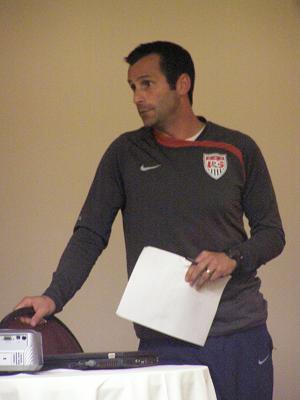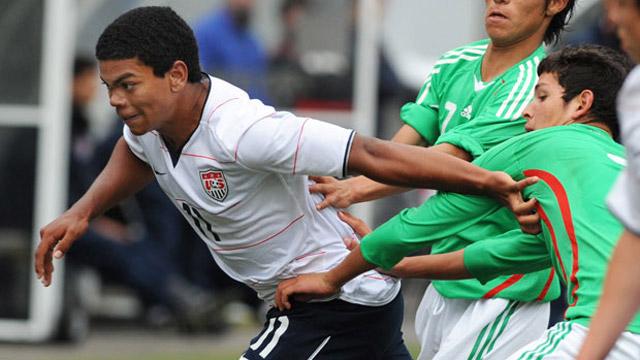 Tony Lepore
Tony LeporeNational Team Selection more sophisticated

January 12, 2012
Part 2 of a three-part series – Read Part 1
Once the players make it to the USSF Training Centers, the process of evaluating their potential suitability for youth national teams begins. Technical Advisors and scouts from a more than 70-strong per diem network run by USSF will be on hand to observe training.
From that point, the scouts begin a conversation about all the players within their respective areas. This is augmented by their continuing to watch those players and others in their natural club environments. The ongoing evaluation leads to decisions about inviting players back for future training sessions. USSF Technical Adviser and Development Academy Scouting Director Tony Lepore said there is regular review of players both nationally and within their regions, to determine if they should be brought in for additional training centers, put on the back burner for the time being or whether new players should be considered for the training events.
 Tony Lepore
Tony LeporeEach Technical Adviser is responsible for knowing his territory well, to forge good relationships with coaches at both the Academy clubs (which he is charged with evaluating technically on a yearly basis), but also outside clubs in an effort to help integrate more teams and players in the national ID process.
Lepore noted that 40 matches on a recently-completed Academy weekend were scouted, and that the actual scouting was only the beginning of the effort (scouting is done as part of the technical evaluation of the Academy teams as well as for the YNT ID process).
“Each team should be scouted 15-20 times over the season. The scouts have to file an online report into our national database by Tuesday morning,” Lepore explained. “Every Wednesday, all scouts and national staff are together on a conference call with me, and we’re looking through each birth year (99 to 93).”
The ongoing tracking process affects invitations to future training centers and possible invitations to youth national team training camps.
“Now when we get on a call on Wednesdays we’ll start talking about 98s and 99s. We might see a kid in one or more training centers, and with their team. We can have a discussion about each of the prospects before we recommend them to national team camps,” he said. “Even if he doesn’t get recommended for the next camp, the kid is in our database now and we’ll keep tracking him, so that database is a really valuable tool.
Lepore added that the Technical Advisers keep a national depth chart of players by position for each age group, so that if someone is looking for the top left-sided defenders in a given area, for instance, the information is readily available. This is partly why the training sessions feature 11v11matches for each age group and only include a few substitutes per side: To limit players standing around idly during the matches, but also so scouts can get an idea of their ability playing at one or more positions.
Lepore said regular overlap between youth national team selection lists and those invited to the training centers is a good feature of the setup.
“It helps us to have national team kids in the training centers, because they help show everyone the gauge, where they can say ‘OK, that’s the standard.’ It helps us make decisions on guys who are on the bubble as we keep tracking them,” he said. “These centers are a place for a lot of future national team players as well as those presently on a (YNT) roster. Maybe some of the guys aren’t physically there, but the ideas are there and the technique is there. So maybe they won’t be part of the 15s, but they can still be part of the 20s.”
Better Decisions and Preparation
A regular supply of training centers, at least in some markets, also helps national staff to be more circumspect in their decision-making about invitations to YNT training camps.
“There are still tough decisions to make on rosters, but they are also more clear,” Lepore said. “We have more information so we’re less likely to take a big chance on a kid so we don’t get someone in over their head and really hurt their confidence going forward. Instead we can just ask ‘When is the next training center? Let’s waits a few weeks and see how he does there.’ It’s rare now where someone is seen once and we say ‘We have to have him in.’ It’s a much more thorough process. There’s much more discussion between camps. The pool has broadened. We start now with a bigger list earlier in the process where that used to be the case later. Now I think the core stays more the same because of so many evaluations. But it’s always open.”
Lepore also noted that the prior experience of the training center helps ensure the players aren’t overwhelmed with their national team experience.
“We’re all coaches so while we do a lot of administrative work, the favorite part of our job is still being on the field with these top players, and getting to know them,” he said. “So when the kids have us at the training centers they really get a sense now, before they actually get to YNT camp, about what to expect. They see how we do things at the national level and what we expect from training. We picked about four or five passing exercises that really translate into the style of play we want, and that’s all the way up to Claudio (Reyna, U.S. Soccer Technical Director) and Jurgen (Klinsmann, U.S. Men’s National Team head coach). We do these same exercises in training centers and at YNT camp. So when they get there it’s not the first time they’ve done it.”
Tomorrow: A look at future developments in the Development Academy including geographically expanding the scouting network, moving to a year-round schedule and the increased involvement of professional clubs in player development.
Trending Videos
Headlines
- SIMA Recruiting Roundup: April 15-21
- How Do I Get Scouted by TopDrawerSoccer?
-
2024 Big 12 Breakout Candidates

- U15 GNT Roster for California Training Camp
-
Commitments: Bound for Boise State

- TopDrawerSoccer TeamRank Update - Girls
-
ECNL Boys Texas U17 Players to Watch

-
Women's Big East Breakout Candidates

-
GA Showcase Under-19 Players to Watch

-
ECNL Boys Texas U16 Players to Watch

IMG Academy Top 150 Rankings
